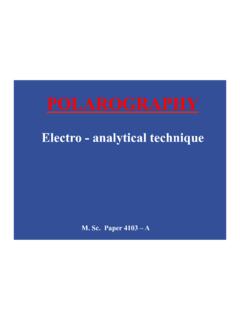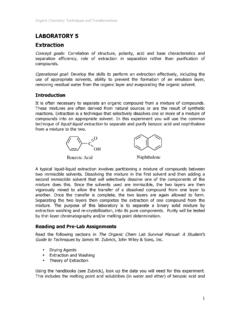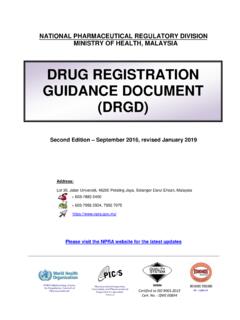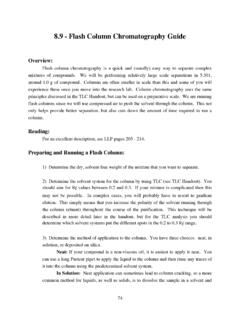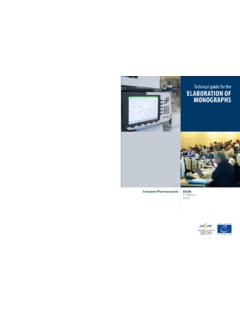Transcription of Thin Layer Chromatography (TLC) - Delhi University
1 Study materials 13/03/2020 to 18/03/2020 thin Layer Chromatography (TLC) thin Layer Chromatography (TLC) is a quick, sensitive, and inexpensive technique used to determine the number of components in a mixture, verify the identity and purity of a compound, monitor the progress of a reaction, determine the solvent composition for preparative separations, and analyze the fractions obtained from column Chromatography . This unit is mainly aimed at novice experimenters, describing in detail the strategies and principal steps for performing a TLC experiment, with illustrations of the relevant instruments, as well as approaches for obtaining and understanding results OVERVIEW AND PRINCIPLES The first widespread application of partition Chromatography on a planar surface was paper Chromatography , introduced in the 1940s. However, paper Chromatography was gradually replaced by thin - Layer Chromatography (TLC), which has become one of the most routinely used Chromatography techniques (Ettre and Kalasz, 2001).
2 TLC is also a liquid-solid adsorption technique where the mobile phase ascends the thin Layer of stationary phase coated onto a backing support plate resembles column Chromatography (UNIT ), where the solvents (eluents) flow down through the column s adsorbent. However, unlike column Chromatography , TLC is a quick, sensitive, and inexpensive technique that only requires a few micrograms of sample for one successful analysis. TLC is commonly used to (1) determine the number of components in a mixture; (2) verify the identity and purity of a compound; (3) monitor the progress of a reaction; (4) determine the solvent composition for preparative separations; and (5) analyze the fractions obtained from column Chromatography . Like all forms of Chromatography , TLC involves a dynamic and rapid equilibrium of molecules between the two phases (mobile phase and stationary phase). However, TLC differs from all other chromatographic techniques in the fact that a gas phase is present, which can influence the results of separation significantly.
3 Between the components of the mobile phase and its vapor, an equilibrium will be established gradually (also called chamber saturation). The part of the stationary Layer that is already wetted with mobile phase also contributes to the formation of the equilibrium (Fig. ). During development, molecules are continuously moving back and forth between the free and adsorbed states (Fig. ). A balance of intermolecular forces determines the position of equilibrium and thus the ability of the solvent to move the solute up the plate (also see Strategic Planning for details). This balance depends on (1) the polarity of the TLC coating material, (2) the polarity of the development solvent, and (3) the polarity of the sample molecule(s). For example, with a sample consisting of two compounds A and B as illustrated in Fig , if the molecules A spend more time in the mobile phase, they will be carried through the stationary phase more rapidly and move further in a certain time.
4 While molecules B are adsorbed to the stationary phase more than A, B molecules spend less time in the mobile phase and therefore move through the stationary phase more slowly, and do not move as far in the same amount of time. The consequence is that A is gradually separated from B as the mobile phase flows (ascends). Figure 1 Schematic representation of ascending development chamber for conventional TLC (side-on view). Figure 2 (A) Mixture of A and B adsorbed on the stationary phase and free in mobile phase and (B) schematic representations of the principle of separation. STRATEGIC QUESTIONS Before performing a TLC experiment and the subsequent analysis, the following questions should be addressed: 1. What type of TLC plate will you use regarding the backing support and coating material? 2. Which solvent system will you choose to achieve the best separation and resolution? 3. How will you handle and develop the TLC plate?
5 4. How will the compounds in your sample be visualized? 5. How will you solve the problems encountered during TLC experiments? 6. Are there any special techniques and tips for a successful TLC analysis? Whether your TLC is successful, as well as the overall time required, depend on each of these decisions. The answers to these questions can be found in Strategic Planning, Protocols, and especially Troubleshooting. STRATEGIC PLANNING Precoated TLC Plates Supports for stationary phases (glass, aluminum, and plastic) Glass has been found to be a very robust support. It is rigid and transparent, and has high chemical resistance and good heat stability. The glass backing is economical (reusable). However, glass plates are relatively heavy and thick. They cannot be easily cut to desired size (see steps for handling and cutting TLC plates in the Basic Protocol, below). Because glass backing is fragile and highly susceptible to breakage, there is also a potential safety issue.
6 Aluminum foil is preferable to all other materials for TLC plates. Compared with glass plates, foil plates are thin , lightweight, and easy to handle. They can easily be cut to desired dimensions with scissors and can be stored in a laboratory notebook. Moreover, aluminum plates have strong adsorbent Layer adherence and are good for use with eluents containing a high concentration of water. However, they are not as chemically resistant as glass to reagents that contain strong acids, concentrated ammonia, or iodine ( , they do not tolerate long treatments in an iodine chamber). Plastic polyethylene terephthalate (PET) film plates are becoming less frequently used. Their advantages ( thin , lightweight, easy to handle, can be easily cut, etc.) are similar to aluminum-foil plates, but their flexibility (adsorbent Layer may be more susceptible to cracking) and considerably inferior heat stability are very marked disadvantages.
7 Adsorbent layers and stationary phases The standard silica coating (silica 60 with a mean pore diameter of 60 A ) is the most commonly used adsorbent in TLC, although for some very sensitive substances less active adsorbents such as aluminum oxide are preferred to prevent sample decomposition. Moreover, in the early days, the use of cellulose, polyamide, and Florisil (magnesium silicate) as adsorbent agents was also described. For selection of an adsorbent, one considers the properties of the compounds to be separated: first, the solubility of the sample compounds (hydrophilic or hydrophobic); then, whether the compounds can chemically react with the adsorbent or the eluent. Based on these considerations it is recommended that: 1. for lipophilic substances: silica, aluminum oxide, acetylated cellulose, polyamide should be used; 2. for hydrophilic substances: cellulose, cellulose ion exchangers, polyamide, and reversed-phase silica should be used.
8 Several different types of TLC stationary phases are listed according to polarity in Figure 3. Figure 4 shows affinity of common functional groups for silica gel (approximate). Assuming that a polar adsorbent (silica gel) is used, the more polar compounds will be eluted more slowly and the more nonpolar compounds will be eluted more rapidly. The charts depicted in these figures are very useful to help predict the order of elution; however, the functional groups should always be viewed and considered within the context of a whole molecule. Clear answers come from real experiments! Figure 3 TLC stationary phase polarities. Figure 4 Affinity of common functional groups for silica gel (approximate). Solvent System (Mobile Phase) Finding a suitable solvent system is usually the most difficult part of TLC experiments, and solvent system is the factor with the greatest influence on TLC. Only in a few cases does the solvent consist of only one component, and mixtures of up to five components are commonly used.
9 No matter how many components are present, the prepared solvent system must be a homogenous system with no sign of cloudiness. Three criteria are usually considered for choosing a solvent system: solubility, affinity, and resolution. The first step in solvent selection is to determine the solubility of the sample. The desired mobile phase will be able to provide the greatest solubility while balancing the sample affinity for the solvent and the stationary phase to achieve separation. Resolution is improved by optimizing the affinity between sample, solvent, and stationary TLC solvent systems contain a polar solvent and a chromatographically less polar solvent. Figure 5 lists some common mobile phase solvents according to their polarities and elution power with silica 60 as the stationary phase (Halpaap s eluotropic series, Halpaap and Ripphahn, 1976; Hahn-Deinstrop, 2006). With these solvents, there are some common combinations for organic molecules with silica gel as the stationary phase (see Troubleshooting for combinations of three solvents for very polar compounds): Hexane (or petroleum ether)/ethyl acetate Dichloromethane (or chloroform)/methanol Pentane/ether Petroleum ether/acetone Hexane/dichloromethane Dichloromethane/ethyl acetate Ethyl acetate/methanol Toluene/acetonitrile Water/methanol (for C18-reversed phase silica) Water/acetonitrile (for C18-reversed phase silica).
10 The easiest way to find a starting point for development is to look up a reference for Chromatography conditions of compounds with similar structure. Meanwhile, consider the affinity for the type of compound (Fig. ), as well as the solvent strength (Fig. ), to make adjustments. If the mobile phase has not been previous reported or determined, start with a less polar combination such as hexane/ethyl acetate and observe the separation. If the components do not move very far, try adding a greater volume or a higher ratio/percentage of the polar solvent. Always compare the separation to the previous plate. If the spots stay at the starting line of the plate, add more of the polar solvent or switch to a more polar combination such as dichloromethane/methanol. If they run with the solvent front (or Rf > ), then add more nonpolar solvent or switch to an even less polar combination such as pentane/ether. It is common to try three to six solvent systems for the first round of method development.


